How to Survive in The Jungle: A Guide for Adventurous Spirits
Jungle area is about 6% of the Earth’s solid surface and can be found mainly at the Tropics. I am sure you know that the largest jungle from our planet is the Amazon Jungle, situated in South America, covering the most of the Amazon Basin. However, some other places that can be called “jungles” are the forests from Nicaragua, the southern Yucatan peninsula, and equatorial Africa or Southeast Asia.
[the_ad_group id=”21″]
Now, if you are the kind of person who likes adventure and wants to try on some jungle exploration, you also have to know a series of tips on how to survive in the jungle. Everybody knows that in these places there are many dangers lurking in the shadows like wild animals or poisonous insects that could cause death in a matter of seconds.
What You Should Know About The Jungle
Yes, Tarzan did grow up in the jungle, but before you put your life in the hands of a story, it’s better to do your own research.
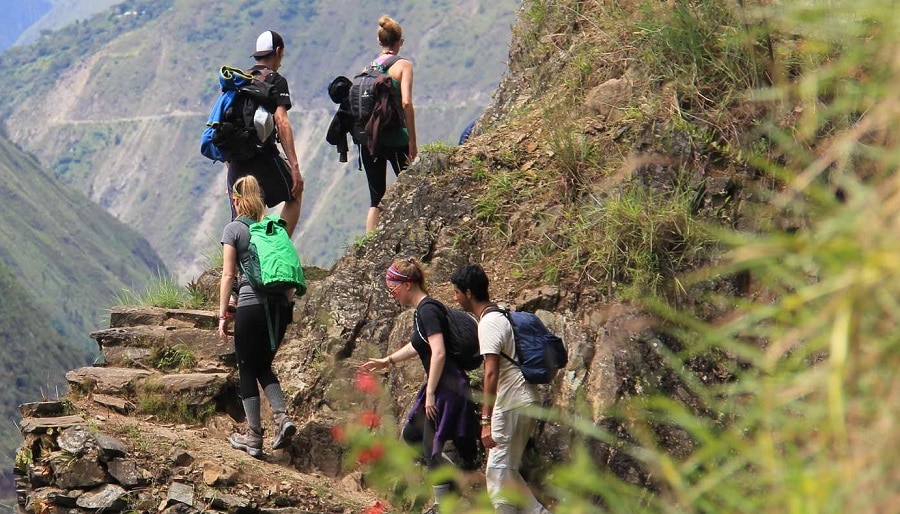
To give you a hand, below are some aspects you must keep in mind in your great adventure in the jungle.
Having the necessary equipment
You can’t start your adventure without taking some important objects which can be helpful for you:
- Baggage. You must choose a rucksack that will satisfy you: large enough to put your stuff into it, but you also need to make sure it won’t get too heavy after you put everything in it.
- Clothing. The perfect type of clothing for a jungle expedition is that which dries quickly and protects you from accidents or dangerous insects. As the weather in the jungle is mainly rainy, it is better to take waterproof clothes or clothes which can dry fast. You must take with you a few long sleeved shirts which are easy to dry and have some useful pockets where you can put different small things.
The trousers you are going to wear should also be full length, because with shorts, your legs will definitely get hurt in the jungle forest. A jacket will be necessary for the evenings and it could be also used as a pillow. Don’t forget to take a nice wide-brimmed hat in order to protect your head and face from the sun and gloves for protecting your hands. - Footwear. The type of the footwear you are going to wear during your expedition is very important for you to be able to move in the forest. Your boots should be both durable and comfortable. It is not recommended to wear waterproof boots because these won’t permit water to enter inside, but they wouldn’t get dry either. Instead, you might consider a military type of boots, for instance. For the top jungle boots you need to survive, check out our must-read article on this.
- Hygiene. Of course, you shouldn’t forget to take your personal things, such as toothpaste and toothbrush, soap and shampoo, towels, deodorant and some other personal object you consider important, but you don’t need to exaggerate because otherwise, carrying your baggage would become a difficult job.
- Health. It is necessary to take with you a good sunscreen and something for sunburns. At the same time, don’t forget to put into your rucksack an insect repellent, a medical kit, pain killers, tablets for allergies and any medicines that you might use. If you decide to take malaria tablets, you must ask for medical advice before you go on your trip.
- Other staff. Certainly, there are some indispensable things to take with you in the jungle. These would be: a sleeping bag, a knife, a machete, a watch, a head torch, a compass, a map, plastic or metal dishes for eating, special containers for water, tools for making the fire.
Orientation: Know how to find your way
The first measure you need to take during your expedition is ensuring you won’t get lost.
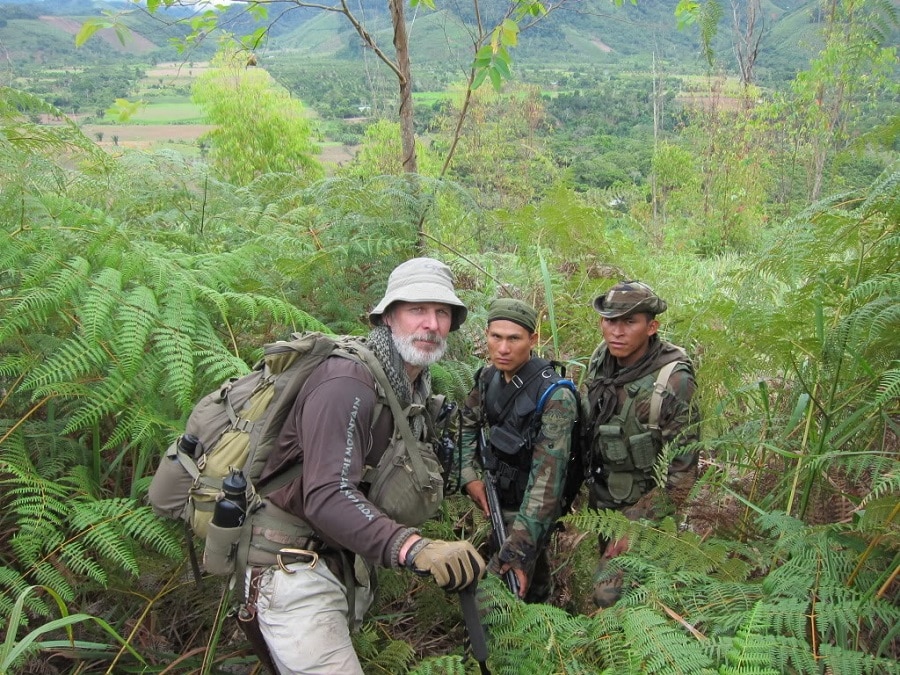
You should know that there are two types of jungles:
- In the primary forests – the forests that weren’t affected by human disturbance – there are very high trees which form a dense dome, and a few bushes.
- On the other hand, secondary forests – the ones that suffered a disruption, resulted mainly from the human activity – the trees are closer spaced than the ones in primary forests.
The problems regarding movement in the first category of forest are the tree canopies which are almost impassable. On the other hand, in secondary forests, you need to move with great attention because here everything looks just the same and, while trying to move in a certain direction, you might go in circles.
Let’s see the things to remember so that you won’t get lost in the jungle forest:
- Share your itinerary with family or friends. Before going on the expedition, you must show your family and friends the place you are going to. They also should know how long you intend to stay there. In this way, if this period will pass, they would know that something is not right and they would organize a rescue action.
- Use tools for orientation. You can’t start this adventure without the necessary objects used for orientation: a compass, a map and a GPS system. These are extremely helpful, but there will be situations in which they just won’t work or they won’t be enough. So, be sure that you have them, but keep in mind other important tips. See how to choose the best hiking GPS for you needs by reading our article on this topic.
- Choose a point of reference. It is important for you to mark the trees or the land you pass so that you might recognize them in case you get lost. You must learn to use the vegetation for your orientation. Consider the Indian people: for them every tree is a unique one, it is just like a certain building for us.
- Find a stream or a river. You must know that in the jungle forests water is helpful in many ways. Besides keeping you alive, water will always help you find the right way. Where there is a river, there are also people, so just follow the course of the river in order to find a good place. If you don’t know where the water is, you might climb the highest tree to look after depressions.
- Be careful with animals trail. Wild animals also offer signs which you can follow in order to find a river and after that, a form of civilization. Animals have better instincts than human beings, so they can find water much easier. You need to look after a thicker trail made by animals and this might bring you to a stream or a river.
How to find Water
Although you might think there is plenty of water because of the continuous rains, finding the right source of drinking water could be sometimes a real challenge. Here are some possible ways to get water in the jungle:
Streams or rivers
The easiest method to drink water is to get it from a stream or a river. If you happen to find something like that, the only thing you should do is make sure the water is good to drink. You might use some tablets for water purification or you can make a fire in order to boil the water and purify it. Check out our review of the LifeStraw personal water filter to give you more options to get potable and safe drinking water.

Keep in mind that water from rivers could contain viruses and bacteria which you usually don’t get in contact with and your immune system is not prepared to fight.
Animals’ signs
As presented before, animals can also help you find sources of water. But you need to discern which the animals to follow for this. For instance, you can count on grazing animals, which usually stay near the water sources.
[the_ad_group id=”22″]
Other great indicators of water are birds or insects. Pigeons don’t fly very far from water and the same happens with bees. On the other hand, there are animals that you shouldn’t follow to find water. It is the case of carnivore animals, which can stay a long period without drinking water or birds of prey which also get water from their victims.
Rainwater
In order to get water to drink, to cook or to wash, you can use rainfalls: when it’s raining, collect water into a container by using a large leaf.
Plants as sources of water
Another important way to obtain water in the rainforest is to get it from plants. You can use for instance, roots, vines or palm trees. The bamboo is also known to collect a lot of water. All you need to do is to bend it so that water could flow out into your container.
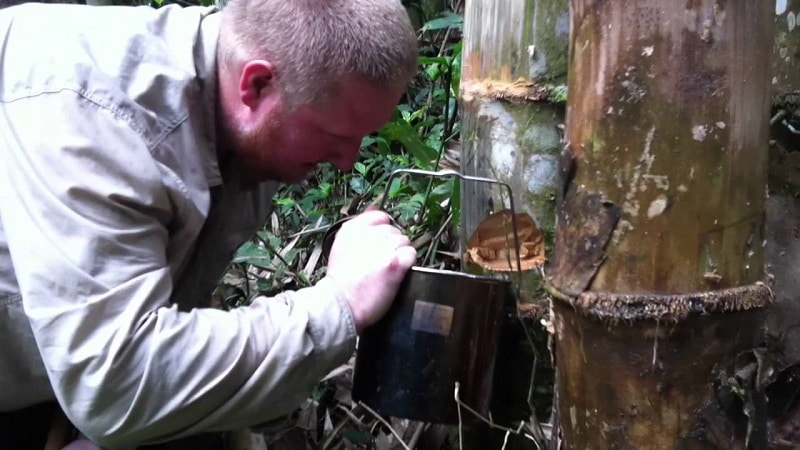
Roots can also be considered as water sources, but you must be careful because some of them provide a poisonous liquid. Palm trees contain a fluid which is very good to drink and could be collected in large quantities.
How to find Food
It is not only water you will need in the rainforest in order to survive. You will also have to find edible food to ensure the necessary energy. In the jungle there are some options you might consider regarding food. These would be plants, fruit, fish, animals or even insects. Let’s see something about each of these categories.
Plants
The best solution for choosing the plants which can be eaten is to have a guidebook or an experienced person to help you, because in the jungle there are a lot of plants that can cause health problems and even death. However, here are some of the plants you must avoid eating:
- plants with yellow or white berries,
- mushrooms – many of them are toxic,
- plants which have leaves in group of three
- plants with thorns or shiny leaves
- plants that produce a milky sap.
Instead, you may choose fruit you can be sure are good like: bamboo, lotus, water lily or wild rice.
Fruits
A good option for food in the jungle is fruit.
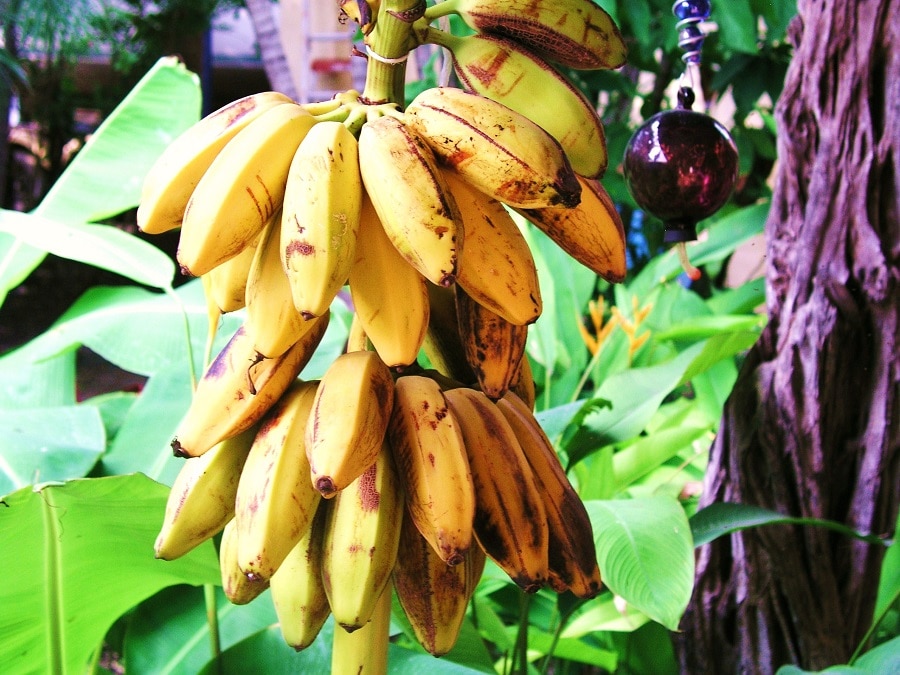
In the jungle there is a great variety of fruits, such as banana, mangoes, coconuts, papaya, sugarcane, bread plant and many others.
Animals
From this category, you may choose birds and small animals, because these are easier to capture and cook. Regarding birds, almost all of them are good to be eaten, except kites or vultures which have a flesh that tastes horrible. Frogs may be another option, as they are considered a real delicacy. Take care to skin the frogs before you cook them.
Fish
There are a lot of fish species in the jungle waters. The only thing you need to do in order to get some fish for your meal is to make yourself a nice fishing spear and start your fishing adventure. Trout, catfish, freshwater salmon, snakehead are only some of the multitude species of fish that could be safely eaten by someone who has an experience in the jungle.
Insects
If you can eat insects, they are recommended as they are a great source of proteins.
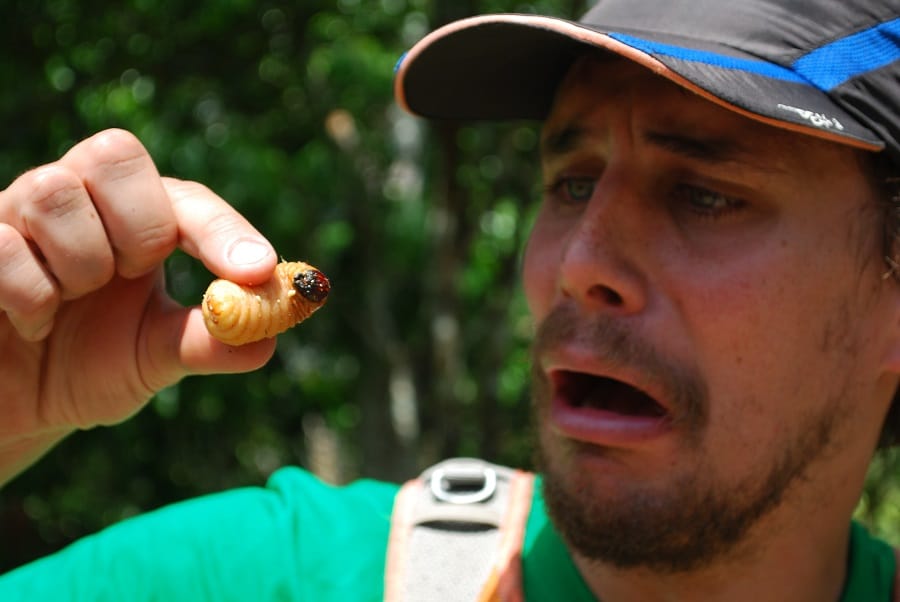
Insects like crickets or grasshoppers, ants or termites, beetle grubs or even worms can be eaten if they are well cooked. You can fry or boil them in order to get rid of toxins.
See also: Edible Snails: How to Find, Prepare and Eat Them
Anyway, there are some insects, like the brightly colored ones or the ones that sting or bite, which you must avoid because they are not safe for your health.
Dangers to Keep in Mind
As you see, surviving in the jungle is possible as you’ll find sources of water and food. However, jungle forests are dangerous places where you must be careful to every step you take because otherwise you might get injured or even die. That’s why it is important for you to know the most dangerous things in the jungle forests.
Wild animals
Many jungle creatures can be quite scary and you should stay as far away as possible. Jaguars, wild boars or cougars are only some of them. However, a special dangerous category is represented by the snakes. Pit vipers, coral snakes, anaconda or cobras are some of the most known serpents which can kill someone in no time.
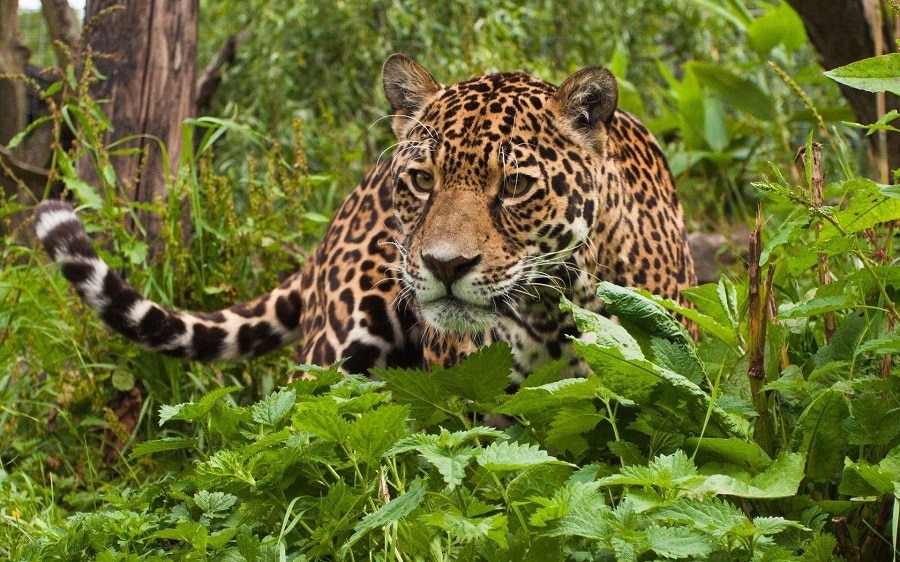
In waters, there are also deadly creatures such as piranhas or the yellow frog, which is a poisonous type of frog.
So, in order to protect yourself from wild animals there are several safety measures to keep in mind. Firstly, you should try to stay silent in order to be able to hear all kind of noises and also not to provoke some creatures.
[the_ad_group id=”23″]
In case you are attacked by an animal, you must keep your calm and move slowly because in this way the animal could retire. If it will see you running, it will certainly attack you.
Insects
In the jungle, even the smallest insects could cause you a lot of harm. You must stay focus so and avoid any insect bite or sting because some of them can transmit deadly viruses. It is the case of spiders or mosquitos. Also very dangerous are known to be the termites or the ants. You must be careful not to step on some of these dangerous insects or to have one of these into your shoes or clothes.
Poisonous plants
As we discussed earlier, some of the plants in the jungle forests are not safe for your health. There are some which you must not eat, but there are also some of them which you shouldn’t even touch.

That is why you must move through the jungle with a knife and a machete in your hands in order to make your way through the vegetation. The poisonous plants are usually the ones which produce a milky sap.
Fallen trees
Surprisingly, in the jungle the trees which fall are more dangerous than the wild animals. You must take care of the vegetation and also be careful to the way you climb trees because you may fall and hurt yourself.
Other Safety Tips
Besides the mentioned safety measures, there are other things to keep in mind in order to stay safe in the jungle:
- In the jungle fire is very important for many reasons. Firstly it helps you cook your food. Secondly, you can use it to warm yourself. It also protects you from the wild animals and keeps the insects away.
- A good shelter made into a tree is very important to stay safe. You might get some ideas from books or the internet in order to build your perfect shelter in the jungle forest.
An adventure in the wild jungle is a unique experience and people who had such a great experience can be considered real survivors.
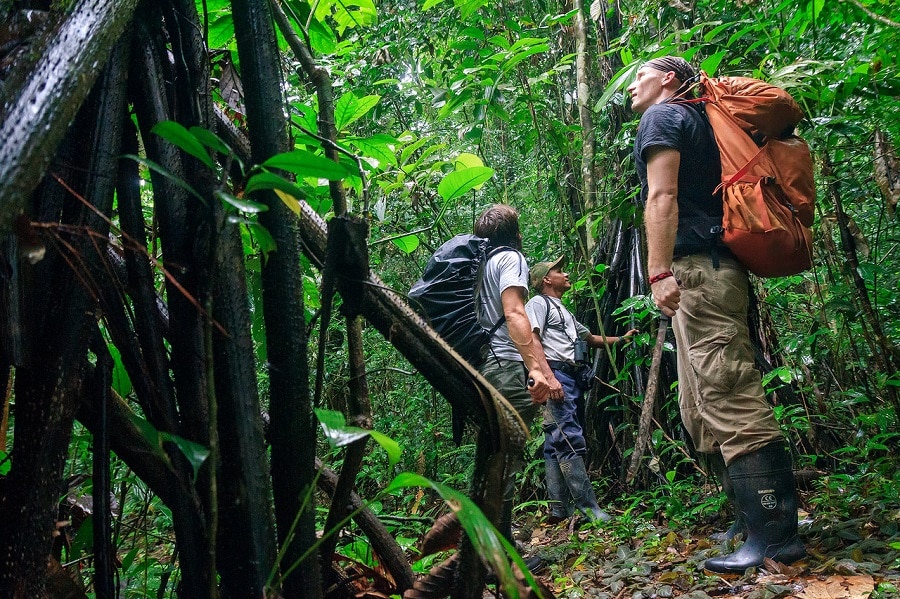
These are very beautiful places, with a lot of interesting things to admire but, at the same time, the jungle remains a place full of dangers and you need to be prepared in order to survive here. You can’t go on such an adventure without a previous initiation.
You must read, talk to experienced people, and watch movies. Remember that your state of mind is very important in order to be a survivor!
To keep you well-informed, read our earlier article on bushcraft skills you need to survive in the jungle.

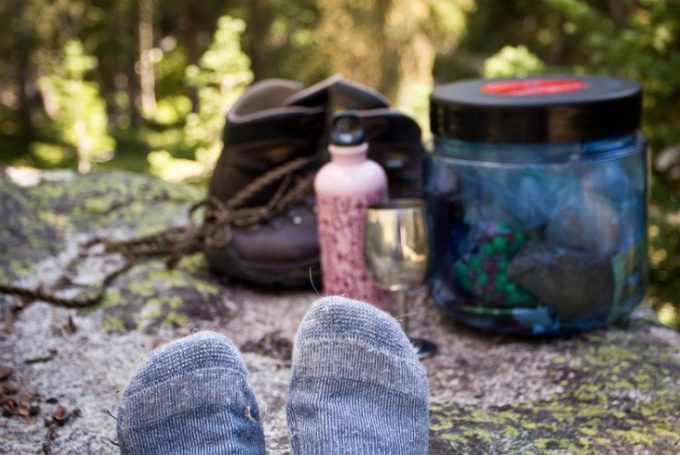
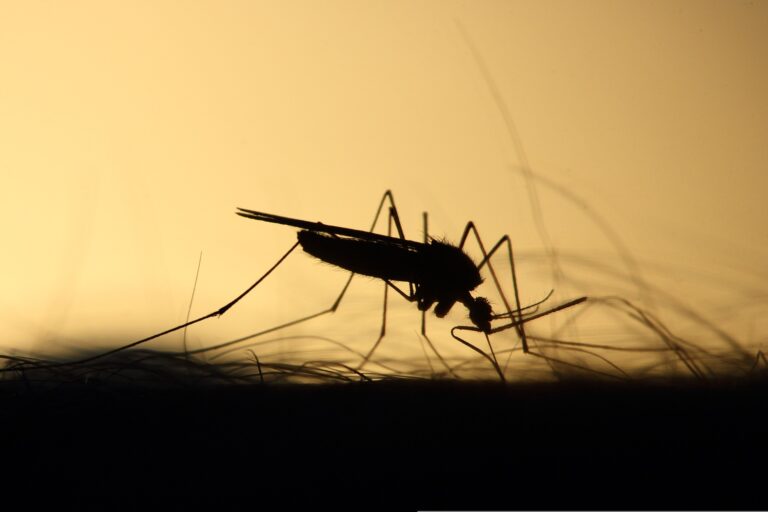
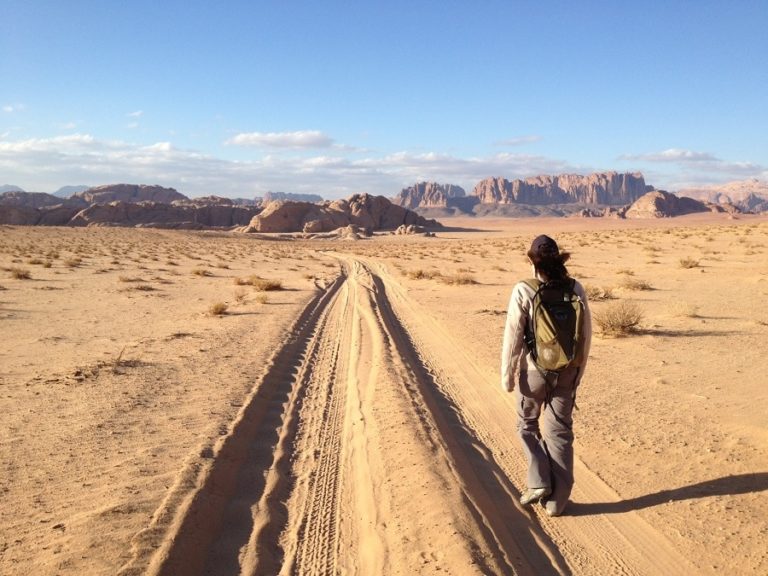
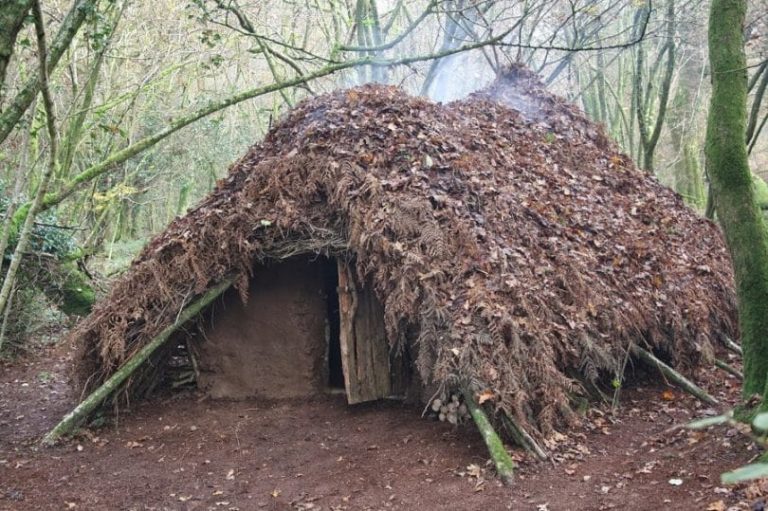
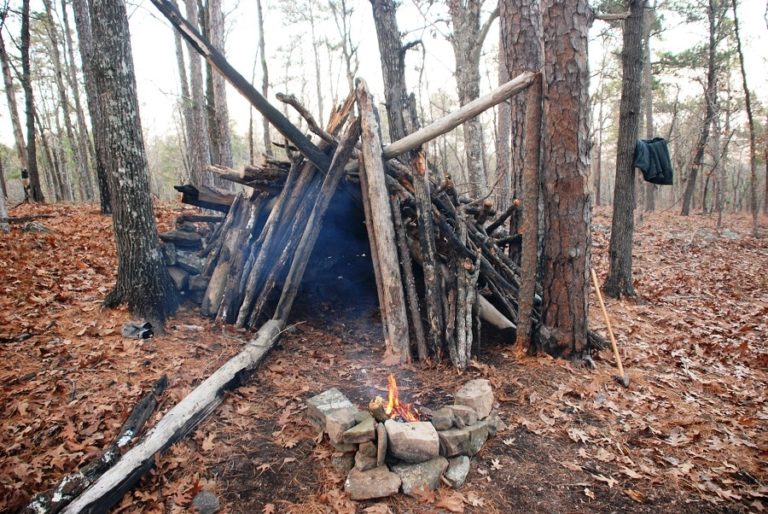

In the jungle, if you don’t have mosquito repellent, you can use the following ways to protect yourself from bites:
– wear long sleeves and pants;
– put the dirt in unprotected places ;
– build a headwear from shirts;
– before you wear a shirt or shoes, carefully check them for spiders and insects.
Hope these advice would help somebody.
Wearing long sleeves and pants alone can help prevent common bite sites which are legs and arms. These little things can go a very long way, and any added protection can help you a lot.
In the jungle, if you don’t have mosquito repellent, you can use the following ways to protect yourself from bites:
– wear long sleeves and pants;
– put the dirt in unprotected places ;
– build a headwear from shirts;
– before you wear a shirt or shoes, carefully check them for spiders and insects.
Hope these advice would help somebody.
Wearing long sleeves and pants alone can help prevent common bite sites which are legs and arms. These little things can go a very long way, and any added protection can help you a lot.
I would also add here some rules to be visible, mark your location: using paper, rope, colored polyethylene, kindle and maintain a bonfire. At the daytime, stay in the open area, put on something bright (from the stuff in your backpack) so that you could be seen from the air. Triple flow signal by any means (whistle, knock on wood, the shots, the on/off light – 3 times in a row+pause) – the worldwide recognized signs of distress.
Visibility is essential to increase the chances of survival and retrieval. The triple flow signal concept is great especially when expecting an aircraft that will pick you from above.
I would also add here some rules to be visible, mark your location: using paper, rope, colored polyethylene, kindle and maintain a bonfire. At the daytime, stay in the open area, put on something bright (from the stuff in your backpack) so that you could be seen from the air. Triple flow signal by any means (whistle, knock on wood, the shots, the on/off light – 3 times in a row+pause) – the worldwide recognized signs of distress.
Visibility is essential to increase the chances of survival and retrieval. The triple flow signal concept is great especially when expecting an aircraft that will pick you from above.